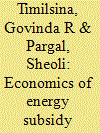|
|
|
Sort Order |
|
|
|
Items / Page
|
|
|
|
|
|
|
| Srl | Item |
| 1 |
ID:
116914


|
|
|
|
|
| Publication |
2012.
|
| Summary/Abstract |
China promulgated the Medium and Long-Term Development Plan for Renewable Energy in 2007, which included sub-targets of 2010 and 2020 for various renewable energy technologies. Almost all the 2010 sub-targets have been met and even surpassed except non-grain fuel ethanol. There is debate surrounding the questions of whether and how the country will be able to meet the 2020 biofuels target. This paper provides the assessment of potential technology pathways to achieve the 2020 target regarding their respective resource potential and supply cost. Barriers and policy options are identified based on broad literatures review. And an overview of biofuels projections is presented to provide insight into the comparison of various policy scenarios. The study shows that China can potentially satisfy non-grain fuel ethanol target by 2020 from technology perspective. But she will probably fall far short of this target if current situations continue. Additional policy efforts are needed. Meanwhile, the target of biodiesel production has high probability to be achieved. However, if given support policies, it will develop better.
|
|
|
|
|
|
|
|
|
|
|
|
|
|
|
|
| 2 |
ID:
176773


|
|
|
|
|
| Summary/Abstract |
The rapid increase in anthropogenic carbon dioxide (CO2) emissions in recent decades is a major concern because CO2 emissions are the main precursor of global warming. Thus, a clear understanding of the factors behind this increase is crucial for the design of policies that limit or at least stabilize global concentrations of CO2. In this study, we investigate factors driving the growth in global CO2 emissions over the last two decades (between 1997 and 2015) using the logarithmic mean Divisia index (LMDI) method. The analysis shows that economic growth is the main driver of CO2 emissions during the 1997–2015 period. Population growth is also responsible for increased CO2 emissions, mainly in low-income countries. Without lowering energy intensity and increasing the deployment of clean and renewable energy, CO2 emissions during 1997–2015 would have been almost 50% higher than the observed level. The analysis also shows that the factors driving CO2 emission growth vary among countries from different per-capita income brackets. The analysis emphasizes the need to reduce CO2 more rapidly in highly industrialized countries and to continue to support reduction of CO2 in developing countries, per the United Nations Framework Convention on Climate Change (1992) Common But Differentiated Resposibilities.
|
|
|
|
|
|
|
|
|
|
|
|
|
|
|
|
| 3 |
ID:
176798


|
|
|
|
|
| Summary/Abstract |
As in many countries around the world, subsidies to energy in Bangladesh impose a significant fiscal burden, with benefits that disproportionately accrue to high-income households. Using a computable general equilibrium model, this study investigates the economy-wide impacts of the removal of direct subsidies in the electricity sector and indirect subsidy in natural gas in Bangladesh. The study finds that the removal of energy subsidies would be beneficial to the economy and would increase GDP. The magnitude of the economic impact depends on how the budgetary savings from the removal of electricity subsidy and the increased revenues due to the removal of indirect subsidies to natural gas are reallocated to the economy. Recycling the savings (or the new revenues) to fund investment would benefit the country most, followed by the case of utilizing them to fund cuts in income taxes, and finally to fund cuts in indirect taxes. While the reallocation of budgetary savings to households through lump-sum transfers is found inferior to other recycling options considered, it could be the preferred from the distributional perspective. However, further analysis is needed to confirm this.
|
|
|
|
|
|
|
|
|
|
|
|
|
|
|
|
| 4 |
ID:
119839


|
|
|
|
|
| Publication |
2013.
|
| Summary/Abstract |
Argentina is one of the world's largest biodiesel producers and the largest exporter, using soybeans as feedstock. Using a computable general equilibrium model that explicitly represents the biofuel industry, this study carries out several simulations on two sets of issues: (i) international markets for biofuel and feedstock, such as an increase in prices of soybean, soybean oil, and biodiesel, and (ii) domestic policies related to biofuels, such as an introduction of biofuel mandates. Both sets of issues can have important consequences to the Argentinean economy. The simulations indicate that increases in international prices of biofuels and feedstocks would increase Argentina's gross domestic product and social welfare. Increases in international prices of ethanol and corn also can benefit Argentina, but to a lesser extent. The domestic mandates for biofuels, however, would cause small losses in economic output and social welfare because they divert part of biodiesel and feedstock from exports to lower-return domestic consumption. An increase in the export tax on either feedstock or biodiesel also would lead to a reduction in gross domestic product and social welfare, although government revenue would rise.
|
|
|
|
|
|
|
|
|
|
|
|
|
|
|
|
| 5 |
ID:
149831


|
|
|
|
|
| Summary/Abstract |
SIDS have both opportunities and challenges – economic, social and environmental vulnerability – for low carbon development. Economically, they are highly dependent on international trade; they have limited domestic markets, too small to provide significant scale economies; their exports are constraint by their isolation and remote location. We provide an overview of current energy situation in SIDS, their goals to adopt low carbon economic development paths, policies already in place or required to achieve the goals and challenges to implement their plans and strategies. The focus is on energy policy landscape that needs to be addressed in order to scale-up renewable energy technologies needed to stimulate low carbon economic growth. We find that SIDS face four key barriers to renewable energy development: information to improve the energy information network by strengthening existing information systems and building awareness of renewable energy; financing mechanisms for renewable energy projects, including regional loan structures and technical assistance to banks; policy supports to implement regulatory frameworks that enable renewable energy development; and building technical capacity among players in the renewable energy field. We recommend “policy enablers” that underlie what could positively impact on renewable energy goals and more broadly energy efficiency and climate change.
|
|
|
|
|
|
|
|
|
|
|
|
|
|
|
|
| 6 |
ID:
125558


|
|
|
|
|
| Publication |
2013.
|
| Summary/Abstract |
Existing literature indicates that theoretically, the earth's wind energy supply potential significantly exceeds global energy demand. Yet, only 2-3% of global electricity demand is currently derived from wind power despite 27% annual growth in wind generating capacity over the last 17 years. More than 95% of total current wind power capacity is installed in the developed countries plus China and India. Our analysis shows that the economic competitiveness of wind power varies at wider range across countries or locations. A climate change damage cost of US$20/tCO2 imposed to fossil fuels would make onshore wind competitive to all fossil fuels for power generation; however, the same would not happen to offshore wind, with few exceptions, even if the damage cost is increased to US$100/tCO2. To overcome a large number of technical, financial, institutional, market and other barriers to wind power, many countries have employed various policy instruments, including capital subsidies, tax incentives, tradable energy certificates, feed-in tariffs, grid access guarantees and mandatory standards. Besides, climate change mitigation policies, such as the Clean Development Mechanism, have played a pivotal role in promoting wind power. Despite these policies, intermittency, the main technical constraint, could remain as the major challenge to the future growth of wind power.
|
|
|
|
|
|
|
|
|
|
|
|
|
|
|
|
| 7 |
ID:
180166


|
|
|
|
|
| Summary/Abstract |
Many countries have undertaken market-oriented reforms of the power sector over the past four decades. However, the literature has not investigated whether the reforms have contributed to economic growth. This study assesses the potential macroeconomic impacts of following the market-based principle in operating and expanding the power system, an important ingredient of the power sector reform launched in China in 2015. The study uses a hybrid modeling approach by coupling a top-down computable general equilibrium model with a bottom-up energy sector TIMES model. The study finds that electricity prices in China would be 20 percent lower than the country is likely to experience in 2020 if the country follows the market principle to expand and operate the power system. The price reduction would spill over throughout the economy, resulting in an increase in the gross domestic product of more than one percent (or more than a billion US dollars) in 2020. It would also have positive impacts on most economic indicators, including household income and international trade. The findings quantitatively highlight the importance of implementing the 2015 power sector reforms in China and further expanding the initiatives in the future.
|
|
|
|
|
|
|
|
|
|
|
|
|
|
|
|
| 8 |
ID:
094898


|
|
|
|
|
| Publication |
2010.
|
| Summary/Abstract |
This paper critically reviews existing energy demand forecasting methodologies highlighting the methodological diversities and developments over the past four decades in order to investigate whether the existing energy demand models are appropriate for capturing the specific features of developing countries. The study finds that two types of approaches, econometric and end-use accounting, are commonly used in the existing energy demand models. Although energy demand models have greatly evolved since the early seventies, key issues such as the poor-rich and urban-rural divides, traditional energy resources and differentiation between commercial and non-commercial energy commodities are often poorly reflected in these models. While the end-use energy accounting models with detailed sectoral representations produce more realistic projections as compared to the econometric models, they still suffer from huge data deficiencies especially in developing countries. Development and maintenance of more detailed energy databases, further development of models to better reflect developing country context and institutionalizing the modelling capacity in developing countries are the key requirements for energy demand modelling to deliver richer and more reliable input to policy formulation in developing countries.
|
|
|
|
|
|
|
|
|
|
|
|
|
|
|
|
| 9 |
ID:
110749


|
|
|
|
|
| Publication |
2011.
|
| Summary/Abstract |
The price of oil could play a significant role in influencing the expansion of biofuels, but this issue has yet to be fully investigated in the literature. Using a global computable general equilibrium (CGE) model, this study analyzes the impact of oil price on biofuel expansion, and subsequently, on food supply. The study shows that a 65% increase in oil price in 2020 from the 2009 level would increase the global biofuel penetration to 5.4% in 2020 from 2.4% in 2009. If oil prices rise 150% from their 2009 levels by 2020, the resulting penetration of biofuels would be 9%, which is higher than that would be caused by current mandates and targets introduced in more than forty countries around the world. The study also shows that aggregate agricultural output drops due to an oil price increase, but the drop is small in major biofuel producing countries as the expansion of biofuels would partially offset the negative impacts of the oil price increase on agricultural outputs. An increase in oil price would reduce global food supply through direct impacts as well as through the diversion of food commodities and cropland towards the production of biofuels.
|
|
|
|
|
|
|
|
|
|
|
|
|
|
|
|
| 10 |
ID:
107503


|
|
|
|
|
| Publication |
2011.
|
| Summary/Abstract |
This study reviews economics of production of second generation biofuels from various feedstocks, including crop and wood/forestry residues, lignocellulosic energy crops, jatropha, and algae. The study indicates that while second generation biofuels could significantly contribute to the future energy supply mix, cost is a major barrier to its commercial production in the near to medium term. Depending upon type of biofuels, feedstock prices and conversion costs, the cost of cellulosic ethanol is found to be two to three times higher than the current price of gasoline on an energy equivalent basis. The median cost (across the studies reviewed) of biodiesel produced from microalgae, a prospective feedstock, is seven times higher than the current price of diesel, although much higher cost estimates have been reported. As compared with the case of first generation biofuels, in which feedstock can account for over two-thirds of the total costs, the share of feedstock in the total costs is relatively lower (30-50%) in the case of second generation biofuels. While significant cost reductions are needed for both types of second generation biofuels, the critical barriers are at different steps of the production process. For cellulosic ethanol, the biomass conversion costs needs to be reduced. On the other hand, feedstock cost is the main issue for biodiesel. At present, policy instruments, such as fiscal incentives and consumption mandates have in general not differentiated between the first and second generation biofuels except in the cases of the US and EU. The policy regime should be revised to account for the relative merits of different types of biofuels.
|
|
|
|
|
|
|
|
|
|
|
|
|
|
|
|
| 11 |
ID:
190626


|
|
|
|
|
| Summary/Abstract |
This study analyzes the impacts on the power sector in the Middle East and North Africa region of three policies: removal of fuel subsidies, enhanced cross-border electricity trade, and a cap on carbon dioxide emissions. The analysis uses a power system planning model that minimizes the total electricity supply cost over 2018–2035 by satisfying specified technical, economic, environmental, and policy constraints. The study shows that the region would save between US$26.3 billion and US$27.5 billion, measured in 2018 prices, by removing subsidies to natural gas used for power generation. Cross-border electricity trade would save US$83.6 billion to US$90.9 billion. The two policies together would yield a reduction of 10 percent in cumulative power-sector CO2 emissions in the region, with a net cost savings of US$111 billion. If a carbon emission-constraining policy is considered to achieve the same level of emissions reduction, the power supply costs will increase by US$97 billion. The study also reveals that the removal of fossil fuel subsidies and expanded cross-border electricity trade significantly complement each other and also to achieve climate change mitigation targets in the MENA region.
|
|
|
|
|
|
|
|
|
|
|
|
|
|
|
|
| 12 |
ID:
092759


|
|
|
|
|
| Publication |
2009.
|
| Summary/Abstract |
This study analyze the potential factors influencing the growth of transport sector carbon dioxide (CO2) emissions in selected Asian countries during the 1980-2005 period by decomposing annual emissions growth into components representing changes in fuel mix, modal shift, per capita gross domestic product (GDP) and population, as well as changes in emission coefficients and transportation energy intensity. We find that changes in per capita GDP, population growth and transportation energy intensity are the main factors driving transport sector CO2 emission growth in the countries considered. While growth in per capita income and population are responsible for the increasing trend of transport sector CO2 emissions in China, India, Indonesia, Republic of Korea, Malaysia, Pakistan, Sri Lanka and Thailand; the decline of transportation energy intensity is driving CO2 emissions down in Mongolia. Per capita GDP, population and transportation energy intensity effects are all found responsible for transport sector CO2 emissions growth in Bangladesh, the Philippines and Vietnam. The study also reviews existing government policies to limit CO2 emissions growth, such as fiscal instruments, fuel economy standards and policies to encourage switching to less emission intensive fuels and transportation modes.
|
|
|
|
|
|
|
|
|
|
|
|
|
|
|
|
|
|
|
|
|